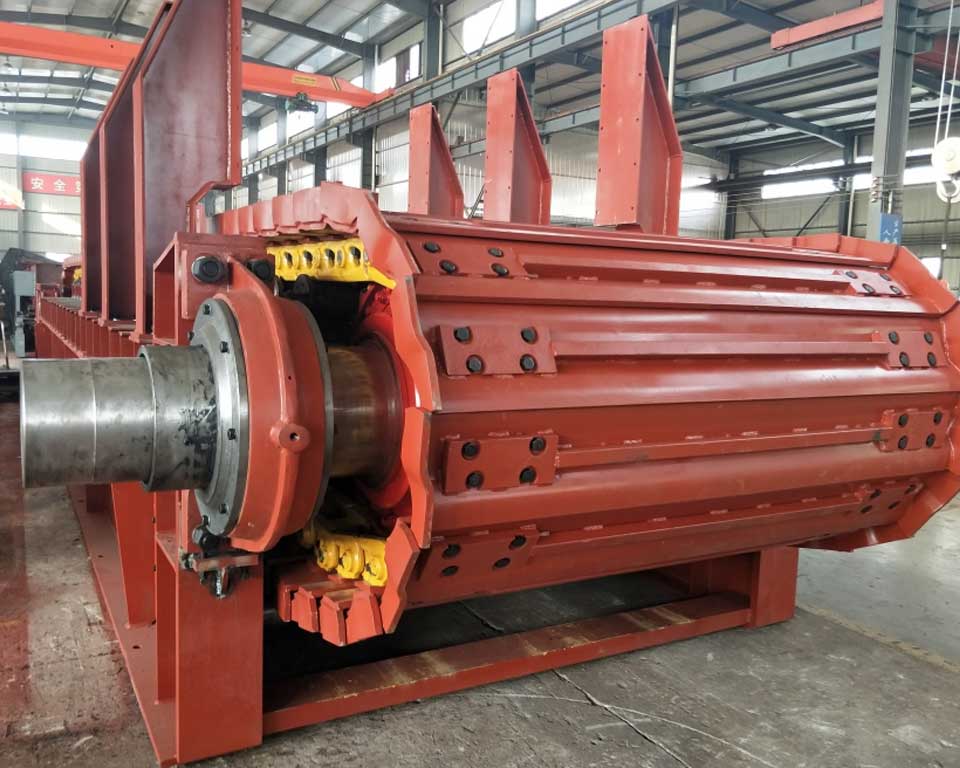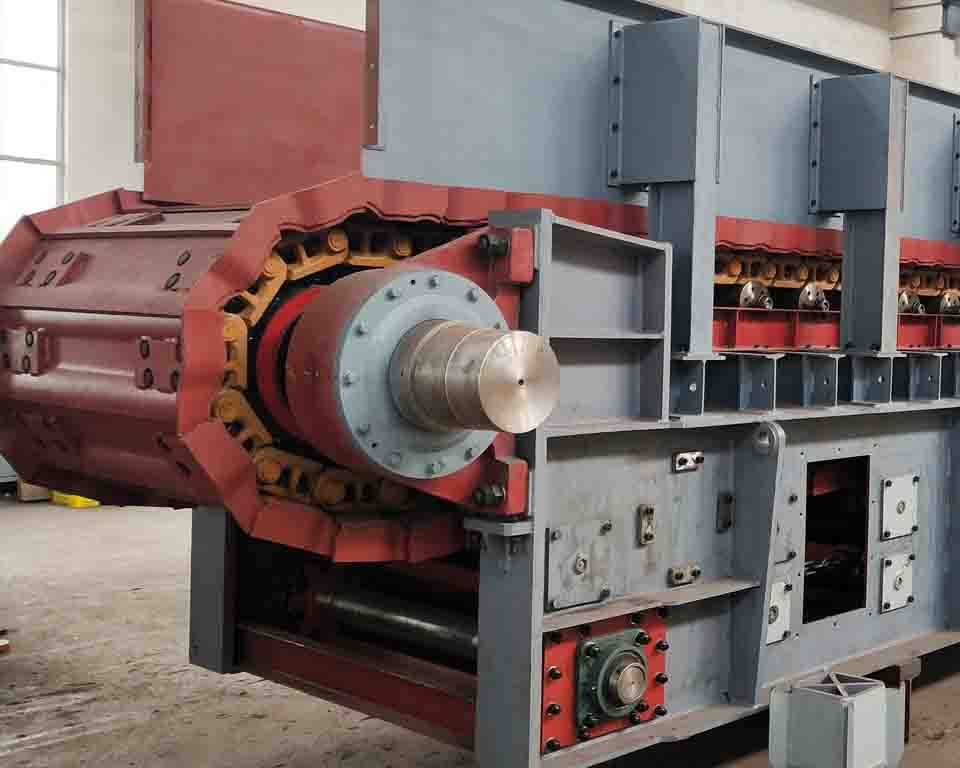Plate Apron Feeder Manufacturers
Apron Feeder
Unrivaled apron feeder, witness remarkable efficiency in mining.
What Is an Apron Feeder?

An apron feeder is a reliable feeding method for a wide variety of applications where the material is too harsh for any other type of feeder, normally to be conveyed is lumpy, abrasive, heavy, high temperature, or where a feeding solution more robust than a traditional belt feeder is required.
The apron feeder is installed to draw material at a controlled rate of speed to transfer (feed) material to other equipment or extract material (ore/rock) from storage stockpiles, bins, or hoppers.
Apron feeders are designed to feed material at a desired volumetric rate to downstream equipment and convey material on a series of overlapping pans attached to multiple strands of a heavy tractor crawler-type chain. Read More: Conveyor System Wikipedia
UHM Plate Apron Feeder can be supplied to suit many applications and installation requirements either horizontal or inclined. At UHM, the apron feeder can provide a positive flow of material with either variable speed drives or control of the material bed depth providing an accurate feed rate. Apron Feeders are well suited for applications that require moving a high tonnage of coarse and wet sticky material with impact loads too severe for other types of feeders.
- Maximum feed particle size range (mm): 300-1400
- Processing capacity range (t/h): 50-900
- Weight range (kg): 3980-85000
Three Types of Apron Feeders
- Types 1 – Light-Duty Apron Feeder: The light apron feeder is a continuous feeding machine, suitable for short-distance conveying of bulk materials with a particle size below 160mm. , Widely used in mines, dressing plants, the chemical industry, cement, building materials, and other departments, from storage bins to crushing, transportation, and other machinery for uniform and continuous feeding. It is generally suitable for materials with a bulk density of less than 1200kg/m3, a block weight of less than 140kg, and a temperature below 350°C.
More Detail - Types 2 – Medium-Duty Apron Feeder: The medium-sized apron feeder is an intermittent feeding machine, suitable for short-distance conveying of bulk materials with a particle size of less than 400mm. Widely used in mines, dressing plants, the chemical industry, cement, building materials, and other departments, from storage bins to crushing, transportation, and other machinery for uniform intermittent feeding. It is generally suitable for materials with a bulk density of less than 12400kg/m3, a block weight of less than 500kg, and a temperature below 400°C.
More Detail - Types 3 – Heavy-Duty Apron Feeder: Heavy-duty apron feeder is an auxiliary equipment for transportation machinery. In the crushing and grading workshop of large mineral processing plants and in the departments of cement and building materials, it is used as a silo for continuous and uniform feeding of primary crushers, and can also be used for short-distance conveying of particle size and specific gravity. Larger materials. It can be installed horizontally or inclined, with a maximum inclination angle of 12 degrees.
More Detail
Four Features of Apron Feeder

- Feature 1: Most of them start with no load, basically no overload phenomenon, and occasionally start with rated load, and the receiving hopper has a maximum of 70t of coal;
- Feature 2: The apron feeder is required to start at zero speed, the speed range is 0~0.6 m/min, and it can be manually controlled to accelerate or decelerate slowly, and the speed is 0.3~0.5m/min to use more and run stably;
- Feature 3: During stable operation, the external load is basically stable and the impact is small;
- Feature 4: The ambient temperature is low and the dust is large.
Five Difference Major Structures

Difference 1: Tensioning device adopts screw tensioning type
The tension support adopts a steel and bolt connection structure, which has a beautiful appearance and is easy to assemble and disassemble. For heavy-duty and super-heavy tensioning devices, a set of springs is added to buffer and absorb shock. In addition, there are the following two features:
- The screw rod of the tensioning device of the medium and light apron feeder is located above the sliding seat and placed under the inverted equilateral angle steel so that the screw part can not be polluted and damaged; for the tensioning device of heavy and super heavy products, the screw passes through the center of the sliding seat.
- The tensioning device is divided into standard type and heavy-duty structure, and it is serialized and generalized with the lower tensioning device of the bucket elevator.
Difference 2: Head and tail bearings mostly use rolling bearings
The head-bearing seat is not supported horizontally on the frame but is vertically connected to the frame with four bolts. In this way, on the one hand, the force on the bearing seat is consistent with the direction of the working pulling force, which improves the stress on the bearing seat and the connecting bolts, and on the other hand, the space size is reduced.
Difference 3: Combined sprocket
The material of the driving sprocket wheel is cast iron or steel, and the wheel rim is made of high wear-resistant hardened steel with a replaceable tooth structure; the gearless rim of the tensioning sprocket is combined and replaceable. This can reduce a lot of maintenance and reduce maintenance costs. In addition, the interchangeable no-gear rim ensures correct and constant contact between the chain and the sprocket, preventing tooth flanks from gluing.
Difference 4: Backup Roller
The support rollers of medium and light apron feeders are external and separated from the traction rollers, which have the following five advantages:
- It is convenient to set the guide rail groove body.
- Reduces traction roller wear.
- Easy to manufacture.
- For heavy-duty and super-heavy-duty apron feeders, set fixed support rollers on the frame.
- The lubrication of the rollers and the head and tail bearing seats adopt a centralized oil supply method to ensure regular and comprehensive lubrication.
Difference 5: Hydraulic coupling
Hydraulic coupling is installed between the driving motor and the reducer, which can ensure the smooth start of the apron feeder and play the role of overload protection. The chain drive is adopted between the reducer and the main shaft, which has a buffering effect, can also make the transmission ratio stable, can transmit high power, and the center distance can be adjusted, which is convenient for layout and installation. The drive shaft is equipped with a backstop to prevent the conveying trough from rotating in reverse.
Other
In addition, for example, the apron feeder is equipped with an automatic metering device for the amount of material, and a dust removal device is installed at the head and tail, which greatly improves work efficiency and is widely used.
Six Advantages of UHM Apron Feeder

- One end of the driving device is suspended on the sprocket shaft, and the other end is supported by a single point. There is no need for a foundation connection, the gear transmission accuracy is not affected by the foundation, and it is easy to disassemble and assemble.
- The conveyor chain plate adopts the bulldozer standard crawler chain produced by professional manufacturers, which does not need lubrication, is easy to install and maintain, has good interchangeability, and long service life.
- The conveyor chain plate adopts a manganese steel stamping and welding structure, adopts precise tooling assembly and welding, and undergoes heat treatment and machining to ensure the arc lap joint accuracy between the chain plates and no material leakage during use. With high strength and rigidity, wear-resistant and durable.
- All key joints are connected by expansion sleeves and locking discs, which will not damage the shaft diameter, reduce stress concentration, and facilitate disassembly and assembly. All rotating parts adopt rolling bearings, which have good sealing performance and lubrication effect, a small resistance coefficient, and low power consumption.
- The tail tensioning device adopts a guide wheel structure, which does not deviate during operation, and is equipped with a composite spring, which can effectively buffer the impact load of the chain belt. The sprocket is made of high-strength alloy steel, and the tooth surface is quenched with high hardness, which has good wear resistance.
- The speed regulation of the apron feeder generally uses an AC variable frequency motor, and other types of speed regulation motors can also be configured according to user needs, and a hydraulic motor drive type can also be configured.